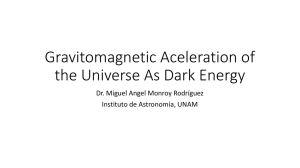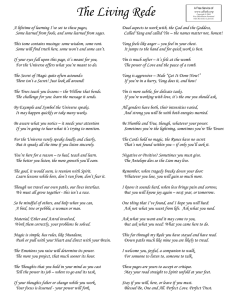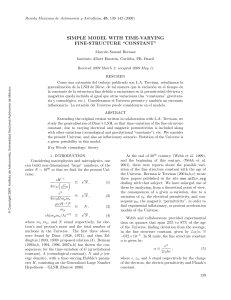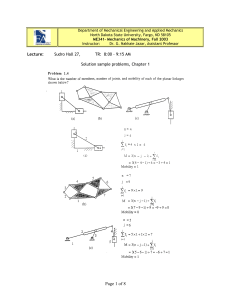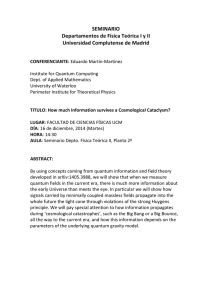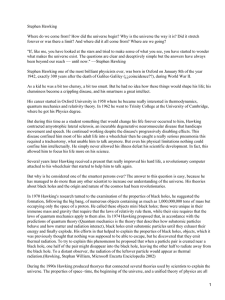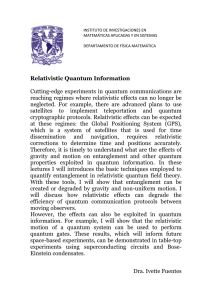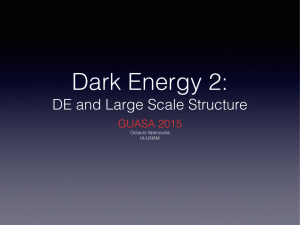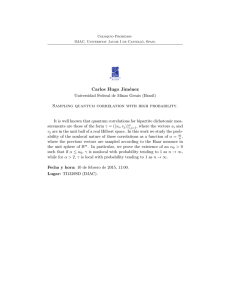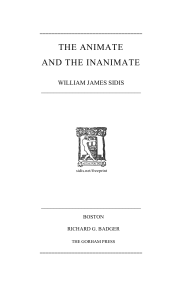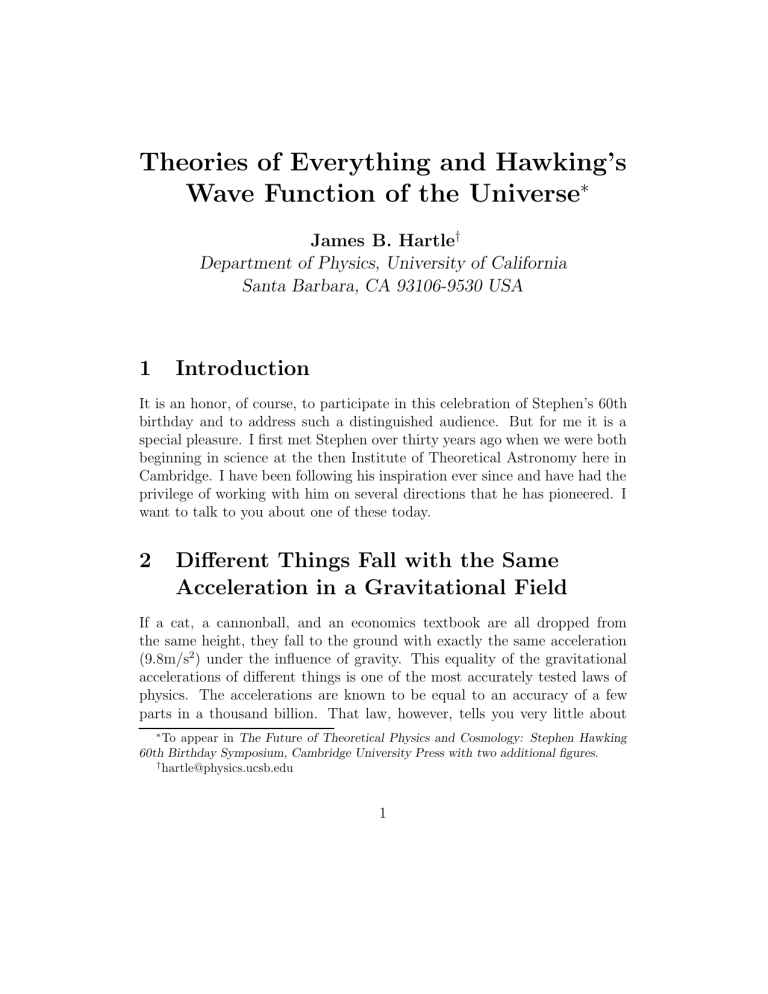
Theories of Everything and Hawking’s Wave Function of the Universe∗ James B. Hartle† Department of Physics, University of California Santa Barbara, CA 93106-9530 USA 1 Introduction It is an honor, of course, to participate in this celebration of Stephen’s 60th birthday and to address such a distinguished audience. But for me it is a special pleasure. I first met Stephen over thirty years ago when we were both beginning in science at the then Institute of Theoretical Astronomy here in Cambridge. I have been following his inspiration ever since and have had the privilege of working with him on several directions that he has pioneered. I want to talk to you about one of these today. 2 Different Things Fall with the Same Acceleration in a Gravitational Field If a cat, a cannonball, and an economics textbook are all dropped from the same height, they fall to the ground with exactly the same acceleration (9.8m/s2 ) under the influence of gravity. This equality of the gravitational accelerations of different things is one of the most accurately tested laws of physics. The accelerations are known to be equal to an accuracy of a few parts in a thousand billion. That law, however, tells you very little about ∗ To appear in The Future of Theoretical Physics and Cosmology: Stephen Hawking 60th Birthday Symposium, Cambridge University Press with two additional figures. † hartle@physics.ucsb.edu 1 Figure 1: The lecture in a nutshell: A cat, a cannonball, and an economics textbook all fall to the ground with exactly the same acceleration if acted upon only by gravity. The equality of accelerations of different things in a gravitational field is an example of a fundamental law of physics. But that law does not tell you much about cats, cannonballs, or economics. [From a transparency used in the lecture]. cats, cannonballs, or economics. That, in a nutshell, is the theme of my talk today (Figure 1). Were a cat, a cannonball, and an economics text dropped from a real leaning tower, the accelerations would not be equal to an accuracy of a thousand billion. Air resistance, magnetic fields, and a host of other effects mask the purely gravitational one. Rather, the equality of accelerations is revealed to that accuracy only in delicate laboratory experiments shielded from such extraneous effects, or in the study of the accelerations of astronomical bodies for which they are not important. The accuracy record holder at the moment is the lunar laser ranging demonstration that the Earth and the Moon fall with the same acceleration toward the Sun [1]. The manned and unmanned missions to the Moon in the late ’60s and early ’70s left behind arrays of corner reflectors. A corner reflector is an 2 arrangement of three mirrors making up the sides of a cube that meet in one corner. It has the property that any light ray incident on the reflector bounces from mirror to mirror and is reflected back in exactly the direction from whence it came. Since 1969 a systematic program to monitor the Moon’s orbit using these reflectors has been carried out by the McDonald Observatory in Texas and the Observatoire de Côte d’Azur in Grasse, France [1]. High powered lasers send light pulses to the Moon that bounce off the reflectors. By measuring precisely the time it takes for the light pulse to return (about 1 sec), and dividing that by the velocity of light, the distance to the Moon can be determined very accurately. About a billion, billion photons are sent out ten times a second and one returning photon is detected every few seconds. The returning photons have been detected for over 30 years, and as a consequence of this effort, we know the position of the Moon relative to the Earth to an accuracy of about a few centimeters. Study of its orbit shows it is falling towards the Sun with the same acceleration as the Earth to an accuracy of a few parts in a thousand billion. This law of equality of accelerations of different things is a cornerstone of Einstein’s general relativity — Stephen’s subject. However, it is not general relativity specifically that I want to talk to you about today, but about such laws of physics more generally. 3 The Fundamental Laws of Physics The equality of gravitational accelerations of different things is an example of a regularity of nature. Everything falls in exactly the same way. The regularity is universal. No exceptions! There are other regularities that may apply to specific systems in similar circumstances. For example, if we drop three cats, they might all go ‘meeeeow’ in roughly the same way on the way down. Or perhaps there are only statistical regularities for cats — 8 out of 10 cats will go ‘meeeeow’ in the average drop. Other systems will do something different according to their own particular regularities. Cannonballs for example do nothing on the way down. But the equality of accelerations of different things is a special kind of law because it applies universally to anything falling in a gravitational field. It is an example of a fundamental law of physics. Identifying and explaining the regularities of nature is the goal of science. Physics, like other sciences, is concerned with the regularities exhibited 3 by particular systems. Stars, atoms, fluid flows, high temperature superconductors, black holes, and the elementary particles are just some of the many examples. Studies of these specific systems define the various subfields of physics — astrophysics, atomic physics, fluid mechanics, and so forth. But beyond the regularities exhibited by specific systems, physics has a special charge. This is to find the laws that govern the regularities that are exhibited by all physical systems — without exception, without qualification, and without approximation. The equality of gravitational accelerations of different things is an example. These are usually called the fundamental laws of physics. Taken together they are called informally a “theory of everything”. Stephen has been a leader in the quest for these universal laws [2]. Today, I would like to ask the question: “How much do we know about the world if we have a theory of everything?” Ideas for the nature of the fundamental laws have changed as experiment and observation have revealed new realms of phenomena and reached new levels of precision. But since they have been studied, it has been thought that the fundamental laws consist of two parts • Dynamical laws that govern regularities in time. Newton’s laws of motion governing the orderly progression of the planets or the trajectory of a tennis ball are examples, as is the law that different things fall with the same acceleration in a gravitational field and the Einstein equation governing the evolution of the universe. • Initial conditions that govern how things started out and therefore most often specify regularities in space. The statistical regularities of the large scale distribution of the galaxies in the universe is a possible example (Figure 2). Laplace is a name associated with this view of a theory of everything. He wrote, famously, [4] An intelligence knowing, at any given instant of time, all forces acting in nature, as well as the momentary positions of all things of which the universe consists, would be able to comprehend the motions of the largest bodies of the world and those of the smallest atoms in one single formula. . . . To it, nothing would be uncertain, both future and past would be present before its eyes. 4 Figure 2: This plot from the 2dF Galaxy Redshift Survey [3] shows the location of 62,559 distant galaxies in two angular slices of the universe approximately 90◦ wide and 3◦ thick as viewed from the Earth. A galaxy’s redshift is used as a measure of its distance from our location at the center. The statistics of the distribution of knots, filaments, and voids in this picture is an example of a large scale regularity of the universe that is directly linked to its initial condition. [J. Peacock and the 2dF Galaxy Redshift Survey Team] That was the theory of everything circa 1820 — Newtonian determinism. Both parts of a theory of everything are needed to make any predictions. Newton’s dynamical laws by themselves don’t predict the trajectory of a tennis ball you might throw. To predict where it goes, you must also specify the position from which you throw it, the direction, and how fast. In short, you must specify the ball’s initial condition. One of Stephen’s most famous achievements is just such an initial condition [2], but not for tennis balls. Stephen’s no-boundary initial condition is for the whole universe. The search for a theory of the dynamical laws has been seriously under way since the time of Newton. Classical mechanics, Newtonian gravity, 5 Figure 3: This picture from the Boomerang experiment [5] shows the temperature distribution across a patch of sky of the cosmic background radiation. The light and dark regions differ in temperature by only a few ten millionths of a degree about a mean of 2.73 K. This is as close as one can come to a picture of the early universe some hundreds of thousands of years after the big bang. The temperature variations are evidence for tiny concentrations of density then which in the intervening 15 billion years grew by the action of gravitational attraction to become the galaxies we see today with the large scale distribution illustrated in Figure 2. Maxwell’s electrodynamics, special and general relativity, quantum mechanics, quantum field theory, and superstring theory are but some of the milestones in this search. But the search for a theory of the initial condition of the universe has been seriously under way for only the twenty years since Stephen’s pioneering work on the subject. Why this difference? The examples used above to discuss regularities governed by the two parts of a theory of everything hint at the answer. The trajectory of a tennis ball was used to illustrate the regularities of dynamical laws, and the large scale distribution of galaxies was used to illustrate the regularities implied by the law of the initial condition. There is a difference in the kind and scale of regularities that the two laws predict. 6 Figure 4: The equality of accelerations of different things in a gravitational field is an example of a local fundamental dynamical law. A body’s acceleration depends only on the gravitational field at its location and not, say, on the arrangement of distant matter or events in the past that could not be summarized in this way. This fundamental law can therefore be discovered by experiments done locally, by experimenters in their laboratories across the universe. [From a transparency used in the lecture.] Dynamical laws predict regularities in time. It is a fortunate empirical fact that the fundamental dynamical laws are local — both in space and time. The trajectory of a tennis ball depends only on conditions that are nearby both in space and time, and not, for example, either on what is going on in distant parts of the universe or a long time ago. This is fortunate because that means that dynamical laws can be discovered and studied in laboratories on Earth and extrapolated, assuming locality, to the rest of the universe. For example, because it is local, the law that different things fall with the same acceleration in a gravitational field can be discovered by experiments in laboratories here, and indeed all over the galaxy (Figure 4). Without that simplicity of the dynamical laws in the here and now it is 7 possible that we would never have discovered them. By contrast, the regularities governed by the law of the initial condition of the universe occur on large, cosmological scales. The universe isn’t simple on small spatial scales. Look at the disorder or complexity in the room we’re in right now for example. But the universe is simple on large, cosmological scales — more or less the same in one direction as in any other, more or less the same in one place as in any other. The mottled map of the cosmic background radiation in Figure 3 illustrates this. In the beginning the universe was opaque, hot, and glowing. As it expanded it got cooler. A few hundred thousand years after the big bang the matter cooled to a temperature at which it was transparent. Light from that time has been propagating to us ever since, cooled to a temperature now of only a few degrees above absolute zero. This is the cosmic background radiation and a map of the temperature of the radiation in different directions, such as that in Figure 3, is the earliest picture we have of the universe. The mottled map in Figure 3 may not look like evidence that the early universe was smooth, but the temperature difference between the light and dark regions is only 30 millionths of a degree. At resolution of your eye the universe would look completely uniform at this time. The reason serious research on the initial condition at the big bang began only recently is that it is only recently that we have had cosmological observations like this that are detailed enough to reveal the regularities it governs. 4 Quantum Mechanics There is another way in which our vision of the fundamental laws and the nature of a theory of everything has changed since the times of Newton and Laplace. That is quantum mechanics. We don’t yet know the final form the fundamental laws will take. But the inference is inescapable from the physics of the last seventy-five years that they will conform to that subtle framework of prediction we call quantum mechanics. In quantum mechanics, any system — the universe included — is described by a wave function Ψ. There is a dynamical law called the Schrödinger equation which governs how the wave function changes in time ih̄ dΨ(t) = HΨ(t) dt (dynamical law). 8 Here the operator H, called the Hamiltonian, summarizes the dynamical theory. There are different forms of H for Maxwell’s electrodynamics, for a theory of the strong interactions, etc. Like Newton’s laws of motion, the Schrödinger equation doesn’t make any predictions by itself, it requires an initial condition. This is Ψ(0), (initial condition). When we consider the universe as a quantum mechanical system, this initial condition is Hawking’s wave function of the universe [2] Probabilities are the key difference between classical and quantum mechanics. Let’s first think about probabilities in classical physics. If I say that there is a 60% chance of hitting an audience member if I toss a ball in this room, I am not expressing a lack of confidence that its trajectory will be governed by the deterministic laws of Newtonian mechanics. Rather the 60% reflects my ignorance of the exact initial speed I’ll impart to the ball, of the influence of air on its motion, and perhaps my ability to do an accurate calculation. If I practice to control the initial condition when it’s thrown, the subsequent evolution of the tennis ball becomes more certain. Probabilities in classical physics result from ignorance. But in quantum mechanics probabilities are fundamental and uncertainty inevitable. No amount of careful determination of the present state of the tennis ball will achieve certainty for its trajectory. In quantum mechanics there is some probability that a ball will take any trajectory as it leaves my hand. However, in classical situations one trajectory — the one obeying Newton’s laws — is much more probable than all the others. The determinism of classical physics is an approximation, but an approximation on which we can rely in many practical circumstances. 5 A Theory of Everything is Not a Theory of Everything My colleague Murray Gell-Mann used to ask me “If you know the wave function of the universe, why aren’t you rich?” A quantum mechanical theory of the Hamiltonian and the initial state does predict probabilities for every event that might happen in the universe. In that is one sense in which it is a “theory of everything”. However, only a few things are predicted 9 with near certainty. The vast majority of alternatives are predicted with approximately 50%–50% probabilities giving no useful information. That’s the sense in which a “theory of everything” is not a theory of everything. We hope that the probability is high for the form of the effective dynamical theories that suffice to predict the outcomes of experiments done in every laboratory constructed so far. We also hope that a theory of everything predicts some large scale features of the universe with near certainty such as its approximate smoothness on large scales, the statistics of the distribution of galaxies illustrated in Figure 2, the vast disparity between the age of the universe and the time scales characterizing the fundamental dynamical theory, and so forth. But it is too much to hope that an interesting probability like that for the FTSE to go up tomorrow is in this category. Since a rise tomorrow is an event in the history of the universe, a quantum mechanical probability could, in principle, be calculated for it from a theory of everything. (Although I suspect that it is well beyond our present powers of computation.) But it’s likely that, after all that work, the predicted probability would be 50% for an upward tick. That is why you can’t get rich knowing the wave function of the universe, and that is why a theory of everything isn’t a theory of everything. But there is a deeper reason why a theory of everything doesn’t explain everything — it’s too short. Everyone with a PC knows that picture files are typically a lot longer than text files. The files for the undergraduate general relativity text that I am writing, for example, consists of roughly 1Mb of text and 100Mb of pictures. A very rough estimate is that it would take a billion, billion, billion, billion, billion, billion, billion, billion, billion (1081 ) compact disks (CDs) to describe the visible universe at a reasonably coarse-grained level of classical description. And that is just at one moment in time! All the matter in the planets, stars, and galaxies in the visible universe would not be enough to make this number of CDs. However, the description of the universe can be compressed because it exhibits regularities on large scales. Compression is an idea familiar from computation. When a large file exhibits regularities its length can be compressed. For instance, a string of 1000 zeros ‘00000000000000000000. . . 0000’ in a file is a kind of regularity. It can be replaced by a shorter string ‘1000 zeros’. The regularities summarized by the laws of nature similarly permit compression. Rather than saying, ‘cannonballs fall at 9.8m/s2 , cats fall at 9.8m/s2 , economics textbooks fall at 9.8m/s2 etc.’, the laws of nature permit us to say ‘everything falls at 9.8m/s2 near the surface of the Earth’. That 10 is shorter and therefore more useful. It is possible that everything we see, every detail of every leaf, every event in human history, every thought, is a long string which is compressible to a law implementable by a very short computer program. But there is no evidence that the universe exhibits such regularity, and even Laplace did not propose such a thing. The initial condition of a deterministic classical theory that did not allow ignorance would have to be as detailed as a present description of the universe. It seems likely therefore that, were world governed by classical laws, it might take so many CDs to write out the law of its initial condition that we could never make the CDs to do it. Let’s contrast this situation in classical physics with Stephen’s no-boundary quantum wave function of the universe. It’s given by the following simple formula [2] Z Ψ= −I[g,φ] δgδφe The no − boundary wave function of the universe ! That’s short! — maybe 45 LATEX key strokes to write out. Furthermore, it’s as complete a description of the initial condition as it is possible to have in quantum mechanics. It implies uncertainty but contains no ignorance. Presumably, the basic equations of the fundamental dynamical theory are similarly short. You might think this a little misleading because I haven’t said what Ψ R means, what g means, and what means, etc. But, even including the lengths of the ten or so texts that physics students read to understand what it all means, a maximum of 10 or 20 Mb would be needed to state the law — easily fitting on one CD. This means the law is the discoverable and implementable, applicable to every happening in the universe, but predicting the near certainty of only a few of its many regularities. A complete discoverable theory of everything is only possible in quantum mechanics where some things are predictable but not everything. Before I left Santa Barbara to come to Cambridge, my colleague Steve Giddings asked me what I was going to talk about in this lecture. I said I would speak on the question “What do we know if we have a theory of everything?” and answer it “Not all that much.” He replied something like “I hope you’re going to say something more hopeful than that!” But it is a hopeful message. It is only because so little of the complexity of the present universe is predicted by the fundamental universal laws that we can discover them. 11 6 Reduction Where do all the other regularities in the universe come from, those particular to specific systems — those of the behavior of cats as they fall, those studied by the environmental sciences like biology, geology, economics, and psychology? They are the results of chance events that occur naturally over the history of a quantum mechanical universe. As my colleague, Murray Gell-Mann puts it [6], they are frozen accidents. “Chance events of which particular outcomes have a multiplicity of long-term consequences, all related by their common ancestry”. The regularities of cats probably do depend a little bit on the fundamental physical laws, for example, an initial condition that is smooth across the universe, leads to three spatial dimensions, etc. But the origin of most of their regularities can be traced to the chance events of four billion years of biological evolution. Cats behave in similar ways because they have a common ancestry and develop in similar environments. The mechanisms which produce those chance events that led to cats are very much dependent on fundamental biochemistry and ultimately atomic physics. But the particular outcomes of those chances have little to do with the theory of everything. Do psychology, economics, biology reduce to physics? The answer is YES, because everything considered in those subjects must obey the universal, fundamental laws of physics. Every one of the subjects of study in these sciences — humans, market tables, historical documents, bacteria, cats, etc. — fall with the same acceleration in a gravitational field. The answer is NO, because the regularities of interest in these subjects are not predicted by the universal laws with near certainty even in principle. They are frozen quantum accidents that produce emergent regularities. The answer depends upon what you mean by reduce. 7 The Main Points Again I have always liked the part of the BBC news called “The Main Points Again”. Here are my main points again: • The fundamental laws of physics constituting a ‘theory of everything’ are those which specify the regularities exhibited by every physical system, without exception, without qualification, and without approximation. 12 • A theory of everything is not (and cannot be) a theory of everything in a quantum mechanical universe. • If it’s short enough to be discoverable, it’s too short to predict everything. • The regularities of human history, personal psychology, economics, biology, geology, etc. are consistent with the fundamental laws of physics, but do not follow from them. But remember also, especially on this occasion, that all the beautiful regularities that we observe in the universe, certain or not, predictable or not, could be the result of quantum chances following from the fundamental dynamical theory and Hawking’s no-boundary wave function of the universe. Acknowledgment The author’s research was supported in part by the National Science Foundation under grant PHY00-70895. References [1] e.g. J.O. Dickey, et. al, Lunar Laser Ranging: A Continuing Legacy of the Apollo Program, Science 265, 482 (1994); J.D. Anderson and J.G Williams, Long Range Tests of the Equivalence Principle, Class. Quant. Grav., 18, 2447 (2001). [2] e.g. S.W. Hawking, The Quantum State of the Universe, Nucl. Phys. B 239, 257 (1984). [3] e.g. M. Colless, G. Dalton, S. Maddox, W. Sutherland, et. al, The 2dF Galaxy Redshift Survey: Spectra and Redshifts, MNRAS 328, 1039–1063 (2001). [4] P.S. Laplace, A Philosophical Essay on Probabilities, translated from the 6th French edition, Dover publications, New York (1951). [5] P. de Bernardis, et. al, A Flat Universe from High-Resolution Maps of the Cosmic Microwave Background Radiation, Nature 404, 955 (2000). 13 [6] M. Gell-Mann, The Quark and the Jaguar, W. Freeman, San Francisco (1994). 14
